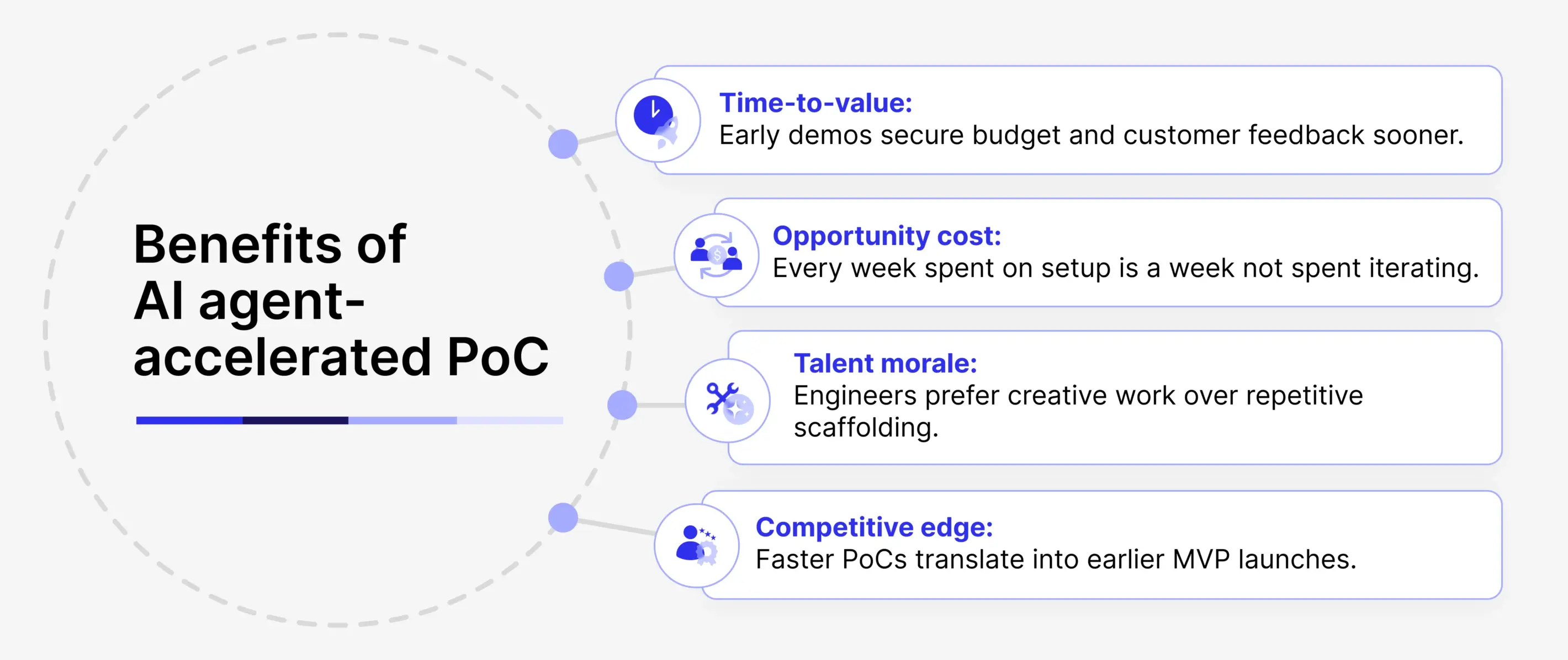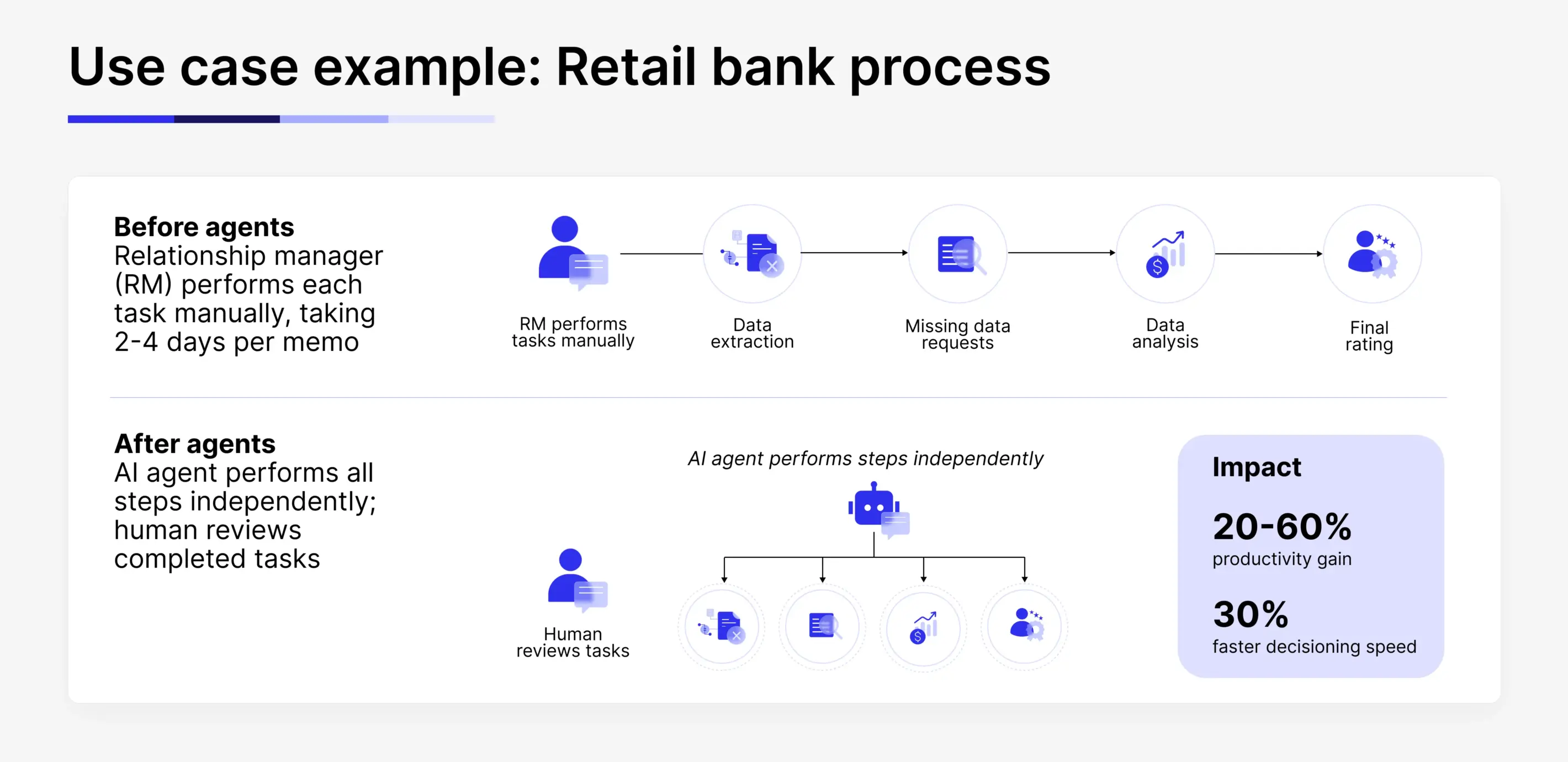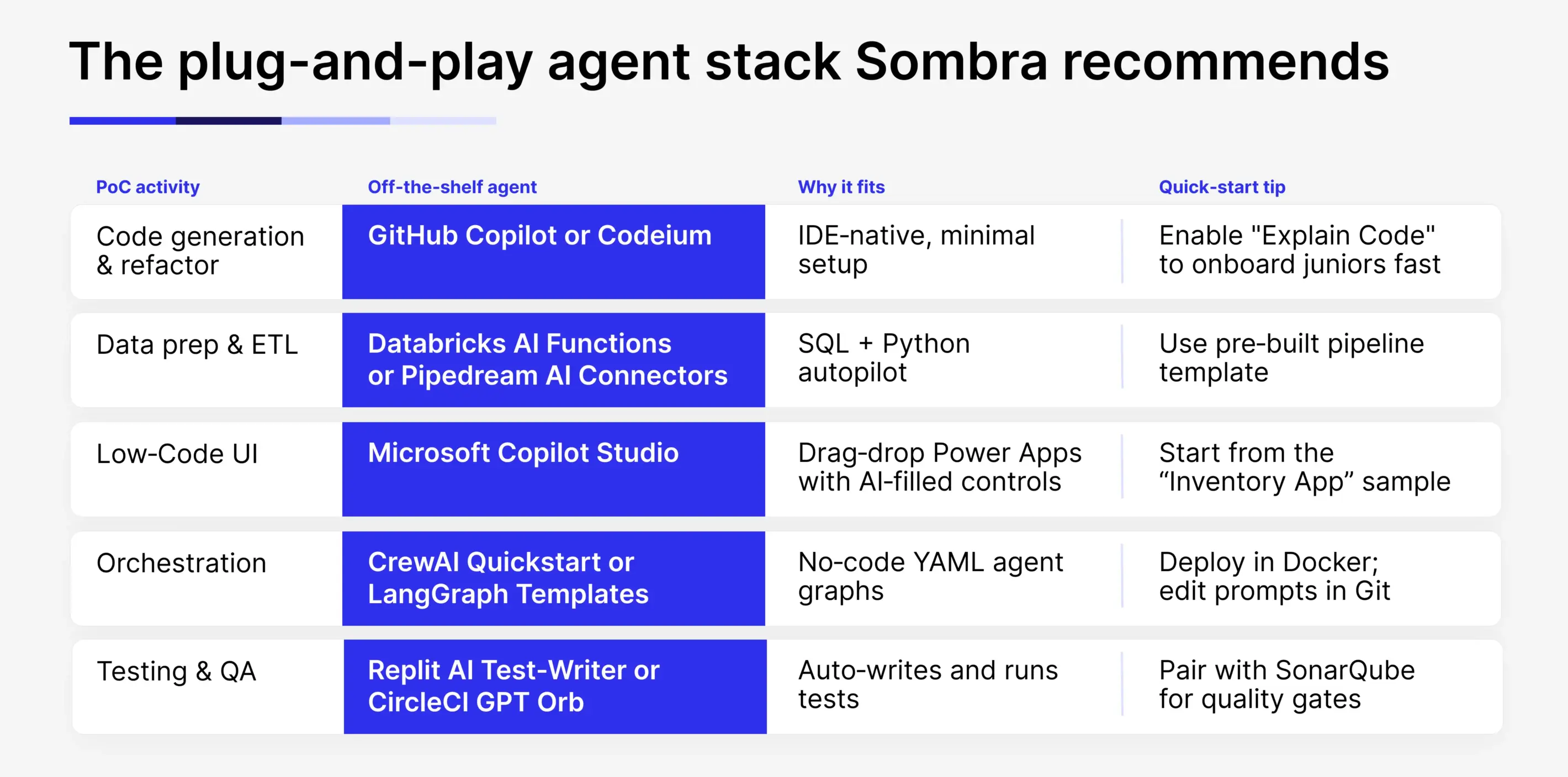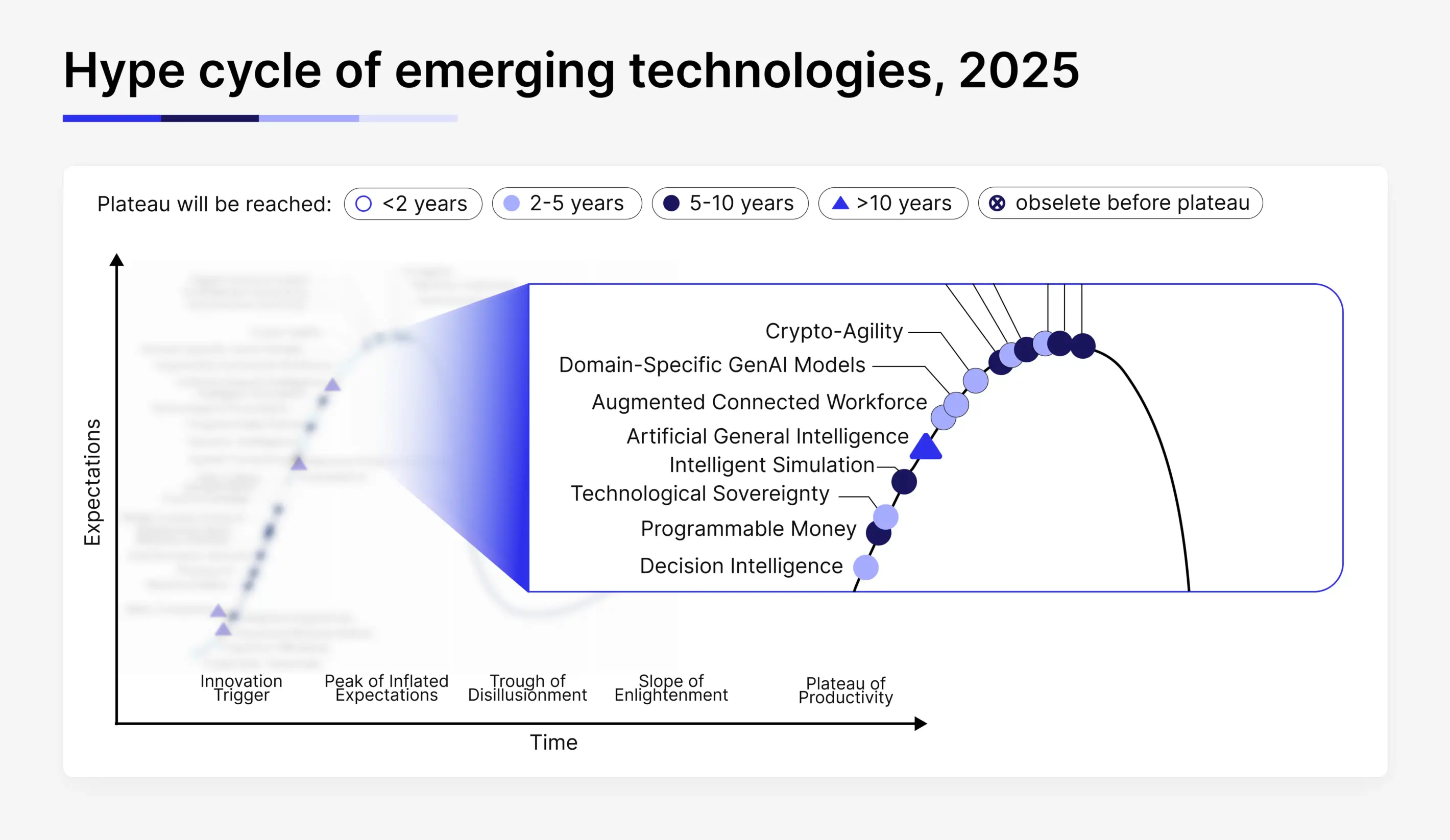The most talked-about topic at tech conferences today? AI. And the only thing that can outshine it right now is its newest iteration — AI agents.
The numbers speak for themselves. The global AI agents market is projected to grow from $5.4 billion in 2024 to over $50 billion by 2030, achieving an astonishing 45.8% CAGR.

Source: Grand View Research
Fueled by automation demands, advances in NLP, and the pursuit of hyper-personalized experiences, AI agents are quickly climbing to the top of Gartner’s Hype Cycle.
According to Gartner’s 2025 CEO and Senior Business Executive Survey, nearly a third of CEOs are already developing strategies to engage with AI agents and machine customers, and another half plan to follow suit within two years.
Yet, despite the enthusiasm, tangible business results remain elusive. CIOs struggle to track AI agent spending amid unpredictable costs, and many organizations are realizing they may be repeating the same mistakes made during the first wave of GenAI adoption. Over 80% of companies still report no material contribution to earnings from their GenAI initiatives, and only 1% consider their strategies mature.
For all the investment and potential, at-scale impact hasn’t materialized. As 2026 approaches, AI innovation is outpacing enterprise and human readiness — leaving IT leaders under pressure to prove ROI, deliver faster, and show measurable progress before the hype fades.
Agents deliver more than efficiency; they boost operational agility and unlock new revenue opportunities.
In this article, we explore how off-the-shelf AI agents can compress proof-of-concept (PoC) timelines by up to 60%, empowering engineering teams to validate ideas with a fraction of the effort — and finally bridge the gap between AI ambition and real business value.
What you get from faster PoC?



Four key advantages of AI agent-powered PoC delivery
Enterprises invest heavily without validating core assumptions early. Proof of Concepts (PoCs) accelerated by off-the-shelf AI agents offer a disciplined, fast-track way to test, learn, and validate hypotheses without draining budgets or timelines. Besides:
- Early demos secure budget and customer feedback sooner.
- Every week spent on setup is a week not spent iterating.
- Engineers prefer creative work over repetitive scaffolding.
- Faster PoCs translate into earlier MVP launches.
Traditional AI development often starts from scratch: building integrations, setting up data pipelines, fine-tuning models, and managing infrastructure. It’s a process that consumes months before a single user interaction is tested.
Off-the-shelf AI agents eliminate this bottleneck.
They come with pre-built capabilities, orchestration layers, and integrations that plug directly into enterprise systems. Instead of infrastructure setting, teams can focus on customizing workflows, logic, and user experience — the elements that differentiate value.
By reducing setup overhead, these agents cut PoC delivery timelines by up to 60% and free your engineering talent to focus on innovation rather than scaffolding. The result:
- Rapid iteration and validation of business hypotheses.
- Faster stakeholder alignment through tangible demos.
- Lower experimentation risk and more predictable costs.
In essence, off-the-shelf agents don’t just make AI development faster; they make it feasible to experiment broadly and scale selectively.
Plus, the industry signals are clear: major vendors are already going agent-native.
Microsoft’s Copilot Studio embeds agents across Dynamics 365 and Microsoft 365; Salesforce’s Agentforce adds a multi-agent orchestration layer; SAP’s Joule-enabled BTP integrates agents directly into business processes.
This evolution marks a shift from isolated pilots to agent-powered ecosystems, where enterprise systems become adaptive, context-aware, and continuously learning.
For IT leaders, the takeaway is simple: the fastest path to enterprise-grade AI isn’t building from scratch, it’s adopting and iterating with off-the-shelf agents that accelerate validation and scale what works.
AI agents: productivity catalysts for PoC sprints
To realize the potential of agents, companies must reinvent how work gets done: by changing task flows, redefining human roles, and building agent-centric processes from the ground up.



Comparison of manual effort agent-assisted efforts in PoC delivery
Sombra can help you do exactly that: see how we can leverage off-the-shelf AI agents to speed up your development processes.
In short, agentic AI doesn’t just automate. It redefines how organizations operate, adapt, and create value.
Real-world examples of accelerated PoCs
Early implementations highlight the speed and productivity gains:
- FinTech AML PoC: GitHub Copilot cut backend scaffold time from 5 days to 1 day.
- Retail Visual Search Prototype: Microsoft Copilot Studio auto‑generated 70% of Power App screens, trimming sprint by 2 weeks.
In more complex scenarios, agentic workflows amplify productivity even further.
For example, relationship managers at a retail bank traditionally spent weeks drafting credit-risk memos to support credit decisions and meet regulatory requirements. Consolidating data from multiple sources (at least 10) and developing a highly nuanced analysis across various sections, like loan, revenue, and cash joint evolution, was a manual task.
Using an agent-powered PoC, the bank automated data extraction, memo drafting, and confidence scoring:
- 20–60% potential productivity improvement
- 30% faster credit turnaround
- Analysts shifted from manual drafting to strategic review and oversight



Source: McKinsey
Tech deep dive: the plug-and-play agent stack we recommend
Below is the stack we recommend to accelerate PoC delivery with off-the-shelf agents:



Plug-and-play stack Sombra recommends
Security and governance essentials
While agentic AI promises autonomy and new revenue opportunities, it also poses new risks. AI agents operate without human oversight, make decisions, and interact with other agents, creating potential vulnerabilities that can disrupt operations, expose sensitive data, or erode trust.
To deploy off-the-shelf AI agents safely, business decision-makers should follow these six key principles:
- Strengthen policies before deploying agents. Update IAM, TPRM, and AI governance policies to cover autonomous, goal-seeking systems. Define agent roles, permissions, access flows, and oversight requirements.
- Update your risk taxonomy. Standard cybersecurity frameworks do not fully account for agentic behaviors. Include autonomy, downstream impacts, and cross-agent dependencies in your risk assessments.
- Maintain an AI agent registry. Track every data connection to prevent experimentation from drifting outside governance boundaries. Cover all PoCs, pilots, and third-party agents.
- Extend identity and access controls. Apply IAM rigor to machine identities. Enforce authentication, least privilege, role-based access (SSO), input/output guardrails, logging, and disable external data logging. Run agents inside your VPC or tenant for maximum control.
- Build traceability into every agent. Log prompts, decisions, agent-to-agent interactions, and system access. Maintain a prompt history in Git for auditability. Observability ensures compliance, supports forensics, and helps debug unexpected behaviors.
- Prepare contingency and isolation plans. Every agent should have clear failure scenarios, kill switches, safe fallback modes, and sandboxed access. If an agent misbehaves, it must be instantly isolated to prevent damage or data leaks.
Pitfalls to avoid
Organizations can falter with off-the-shelf AI agents if best practices are not followed. Here are four common pitfalls and how to avoid them:
Prompt drift
Over time, prompts can evolve unintentionally, leading to inconsistent agent behavior. Treat prompts like code: version them, track changes, and review updates regularly to maintain alignment with business objectives.
Shadow-IT subscriptions
Unmanaged agent subscriptions can create security and budget risks. Centralize billing and approvals to maintain visibility, control, and compliance across all AI tools and platforms.
Over-automation
AI agents are powerful, but humans still need to oversee critical decisions. Keep humans in the loop for architectural choices and high-stakes workflows to ensure alignment with strategy and risk tolerance.
Compliance gaps
AI agents handle sensitive data, and improper handling can create regulatory violations. Validate that all data ingestion and processing meet standards such as GDPR and SOC 2 before deployment.
By addressing these pitfalls proactively, organizations can ensure the safe, effective, and reliable adoption of agentic AI while maximizing the speed and value of proofs of concept and innovation initiatives.



Conclusion
Like any truly disruptive technology, AI agents have the power to reshuffle the deck. Done right, they offer laggards a leapfrog opportunity to rewire their competitiveness. Done wrong—or not at all—they risk accelerating the decline of today’s market leaders. This is a moment of strategic divergence.
Organizations that adopt agent-accelerated PoCs today will surpass competitors, rewire operating models, and unlock the full potential of AI. Those who delay risk widening the gap between investment and impact.
Success with AI agents requires more than speed; it requires discipline, governance, and strategic alignment. By combining accelerated PoCs with robust security, oversight, and a clear roadmap for scaling, enterprises can turn AI ambition into measurable business value.
With Sombra, you get reliable AI engineering services to help leverage off-the shelf AI agents the right way. Contact us to get a free 30-minute consultation and explore the capabilities we provide for your business growth.













